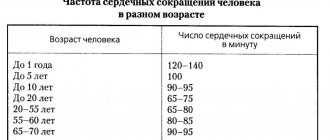Normally, the pulse when walking differs from the indicators at rest by 30-40 beats/min. The final figure on the heart rate monitor depends on the duration and speed of the walk, as well as on the person’s health condition. For example, obese people expend more energy walking, which means their heart rate rises faster. In children, the heart rate when walking (and during rest) is higher than in adults, while closer to adolescence the difference disappears. Of course, for absolutely all athletes, heart rate indicators are directly dependent on the intensity of the workout - the longer and faster you move, the higher the heart rate monitor readings will be.
And yet, there are norms, deviation from which signals health problems. It is important to know them in order to sound the alarm in time. In this article we will tell you what heart rate is considered normal when walking in women, men and children, as well as what to do if your data does not fit within healthy limits. But, before moving on to the numbers, let's find out what this indicator actually affects, why follow it?
The importance of heart rate during training
Monitoring heart rate during training is necessary to:
- determine the intensity of classes;
- effectively use oxygen to generate energy during aerobic exercise;
- choose a load to develop endurance;
- prevent stress on the cardiovascular system.
Those who have problems with the heart and blood vessels should be especially careful during exercise. For such patients, the load is selected based on an ECG machine with tests on a bicycle ergometer.
A sudden achievement of maximum heart rate is also contraindicated for those who have not previously exercised at all. Like other muscles in the human body, the heart needs time to reach a certain exercise regime. The duration of the preparatory period should be from three to six months.
With the correct load, heart rate should be measured several times:
- before classes;
- after warming up;
- at the end of the main part;
- when the load decreases;
- after classes during the cool down process.
IMPORTANT! Pulse is considered a more objective criterion of literacy in classes, in contrast to well-being.
Normal heart rate when walking on a treadmill
The heart rate when training on a treadmill depends on the degree of load and the tasks set. You should proceed from the maximum possible heart rate, which is calculated by the formula: 220 – age.
If your goal is fat burning, then your heart rate per minute should be 60–70% of this number. If you want to strengthen the cardiovascular system, then 70–80%.
For example, if you are 25 years old, then your maximum heart rate is 220 – 25 = 195. This means that during intense training, your heart rate should be 195 x 60% = 120 beats/min.
Using the formula, calculate the heart rate value for aerobic exercise.
Interesting video on the topic:
Pulse zone
Pulse is the rate at which the heart beats over one minute. There is also the concept of a pulse zone, which determines the range from the heart rate at rest to the maximum load on the body.
In everyday life, a person does not need to monitor his pulse zone. But for athletes this parameter is very important. The fact is that when the heart rate is in only one zone, it promotes weight loss; at high values, the endurance of the human body increases
Help: Each person has his own pulse zone, which is determined using laboratory tests.
Normal heart rate limits when walking fast
The heart rate increases with increasing stress on the body. You can test your fitness level by climbing stairs. To do this, walk up to the 5th–6th floor and measure your heart rate. If the data obtained was 100 beats/min, you are in good shape, 120 is an average level of training, more than 120 is an unsatisfactory result.
If a woman has a contraction frequency of more than 120 beats per minute at an accelerated pace, she needs to train more often and for longer. If your heart rate is 140 beats per minute, you should switch your workouts to a gentle mode and breathe deeply during exercise. This indicator value indicates heart overload and can be harmful to health.
Safe heart rate during exercise
Heart rate is an objective criterion for assessing training load during training. Using heart rate, you can regulate the intensity of your exercise.
During aerobic exercise, heart rate indicators are not informative and cannot be used to regulate strength loads in the gym.
During sports exercises
Physical activity makes the heart beat faster. As a result, the volume of pumped blood is often released into the system to supply the human muscles and organs with oxygen, so the number of shocks increases greatly.
If the body has not previously been exposed to heavy exercise, then a high heart rate during sports is considered normal. For professionals, even during training, the heart rate increases slightly, which is explained by constant cardio loads. The heart muscle gets used to it over time and copes with pumping blood without effort.
Heart rate during strength training
Strength loads are characterized by higher heart rate readings, unlike walking or running. After them, the pulse rises to ninety percent of the maximum, but this value is suitable for healthy people. When there is no preparation or a person has suffered from any illness, the heart rate cannot be increased above 85%. For example, if a person is forty-five years old, then the permissible limit is 85% of the maximum: 220 − 45 = 175, which is 149 beats per minute.
The main thing here is to wait for the pulse to recover before another approach. He should get back to ninety beats per minute. A person should not experience shortness of breath, increased heart rate or discomfort in the heart area. If the pulse has not decreased in seven minutes, then this indicates an incorrectly selected load, and it must be reduced.
Help: If you do strength exercises with a constantly high heart rate, this can disrupt the nutrition of the myocardium.
During cardio training
This category includes fitness training. In other words, your heart rate should be between 135 and 150 beats per minute. But first you need to undergo a special computer examination, which will help determine the upper and lower pulse threshold.
Help: The duration of cardio training should be from forty to fifty minutes.
Heart rate while walking
Walking is extremely beneficial for the human body. They improve well-being, lift your spirits and promote weight loss. The normal heart rate when walking is from 100 to 125 beats per minute. At rest, normal rates are from sixty to one hundred beats per minute.
Heart rate when running in women and men
Normally, the pulse of women and men is different, but besides this indicator, there are others that radically change the final value.
The normal heart rate for men can be determined using averaged data. There are several types of loads, and they all differ in maximum heart rate and training efficiency.
For a man with average physical shape:
- warm-up - from 95 to 115 beats per minute;
- walking - from 115 to 135;
- jogging - from 134 to 154.
Help: Anything higher than the presented indicators is considered excessive and has a negative effect on the human body.
Women's indicators are as follows:
- warm-up - from 97 to 117 beats/min;
- walking - from 117 to 136;
- jogging - from 136 to 155.
While cycling
With such loads, the heart rate becomes seventy percent higher than the maximum. This frequency is used to restore the body after high loads; it can be alternated with an active mode within 70–80 percent.
If classes are held within 75% of the maximum, then endurance increases and fat burning occurs. You can move into the zone with a heart rate of eighty or ninety percent of the maximum and above for no more than one minute.
Heart rate during interval training
These are aerobic exercises that differ from standard ones in that they involve alternating pace and level of stress on the body. This type of training is used by bodybuilders, as interval training helps burn fat without losing muscle mass and increases the volume of the heart, which helps bodybuilders cope with pumping a large volume of blood.
The heart rate during such training ranges from 90 to 100 percent of maximum. Of course, there are programs that assume smaller values. Here everyone chooses the program that suits them best.
What should your heart rate be when walking calmly?
At rest, heart rate is 60–80 beats/min. The average walking pulse of a healthy person is 100 beats/min. The increase is due to the fact that the body requires more energy during exercise. The heart is forced to pump blood faster to make up for the lack of oxygen and nutrients.
This figure depends on gender, age, bad habits, body weight, and level of physical fitness. The state of the environment and air temperature also affect cardiac activity. Walking at a calm pace, a person practically does not strain physically.
Therefore, the heart rate when walking is on average 105–112 beats per minute. An increase in this indicator indicates anaerobic load, which promotes weight loss.
Maximum heart rate in older people
In older people, it is contraindicated to increase the maximum heart rate to ninety percent; seventy percent is enough. These recommendations are suitable for people who do not have heart problems.
But if a person has suffered a heart attack, has angina pectoris or arrhythmia, then it is necessary to select an individual pulse threshold. This can only be done using an ECG with stress. Its meaning is that the patient’s electrocardiogram is recorded at the time of exercise. The doctor uses it to find the maximum limit that the patient should not exceed.
How age and gender affect heart rate when walking
Heart rate norms during physical activity differ between women and men, although not much. Age also makes some adjustments. When determining the maximum and normal heart rate while walking, an athlete must take into account age and gender characteristics:
- For men - 100–110 beats/min at an average pace. However, it is difficult to find a representative of the stronger sex with ideal cardiac performance. This is due to a sedentary lifestyle, bad habits, and low levels of physical activity.
- For women, the normal heart rate when walking is 100–120. In them, disturbances in the normal rhythm of the heartbeat can be caused not only by diseases. Natural causes of failure are pregnancy or hormonal imbalance during menstruation. Emotional state also matters.
- The child’s body spends a lot of energy on growth and physical development. In childhood, the heart rate differs from the heart rate in adulthood and is 90–120 at rest. The older the child, the more the average heart rate when walking approaches adult norms.
- In older people, the heart rate should not be too different from the figures for a middle-aged person. However, over the years, the likelihood of cardiac diseases increases. Illnesses can provoke an imbalance in the functioning of the heart muscle. This leads to an increase in heart rate at the slightest physical exertion. Even walking up a flight of stairs can cause your heart rate to increase.
If your heart rate is low during exercise
A low heart rate during exercise, as noted above, indicates a disruption in the functioning of the cardiovascular system. Doctors say that people who do not reach one hundred beats per minute in six minutes are at risk of developing a complex form of arrhythmia in the future, so they need to be examined.
A slow pulse is affected by blood pressure lowering medications for tachycardia, lack of thyroid hormones, and stomach ulcers. Professional athletes tend to have low heart rates due to overtraining.
You need to know your pulse during training in order to exercise effectively without harming your heart. For the calculation, the maximum value and zone of permissible increase in aerobic loads are used. The correct training plan is one that slows your resting heart rate.
What to do if your heart rate is high
High heart rates are called tachycardia. If you suddenly feel suffocation and heaviness in your chest while walking, stop and take a deep breath. If attacks occur frequently and are not associated with increased physical activity, this is a reason to consult a doctor.
In the event of a sudden attack of tachycardia, call an ambulance, and take a comfortable position, try to relax and breathe deeply. Before the doctor arrives, you need to open the windows in the room, unfasten the clothes that are compressing the sternum and put a cold compress on your head.
To prevent heart problems, give up cigarettes and other bad habits in favor of an active lifestyle.
Normal in children
So, we have found out what the pulse should be during normal walking for men and women, now we will consider the norm for children.
Remember your little ones: how often do we get touched, where do they get so much energy? Indeed, a child’s body functions much more intensively than an adult’s, and therefore all processes proceed faster. Children are constantly growing, and this requires a lot of effort. This is why a high heart rate when walking in a child is not a violation.
Tall, based on the parameters for adults. For children it is quite normal. Do you remember what is the normal heart rate for an adult when walking, we wrote about this above? From 100 to 130 beats/min. How much do you think a child's heart rate should be when walking? Remember, the normal range is from 110 to 180 beats/min!
At the same time, age is of great importance - closer to 10-12 years, the standard is compared with the indicators for an adult. After walking or at rest, the children's pulse should be in the range of 80-130 beats/min (for children from 6 months to 10 years).
If you are wondering what a child's heart rate should be when walking fast at a specific age, use the universal formula:
A = ((220 - A) - B) * 0.5 + B;
- A – child’s age;
- B – pulse at rest;
- N – pulse value during sports activity;
Let's say your son is 7 years old. You measured his rhythm before walking and got a value of 85 beats per minute. Let's do the calculation:
((220-7)-85)*0.5+85 = 149 beats/min. This indicator for this child will be considered the “golden” norm. Of course, we recommend using special heart rate monitors.
Normal for women
Walking for ladies is an extremely useful activity. It improves well-being, lifts your mood, and promotes weight loss. Useful for expectant mothers as it provides an additional supply of oxygen.
The normal heart rate when walking in middle-aged women (20-45 years old) is 100 – 125 beats/min. At rest, 60-100 beats/min are considered normal.
Please note that if regular observations show that the values are within the normal range, but are always within the upper limit, this is not a good sign. Especially if other “bells” are observed - pain in the sternum, shortness of breath, dizziness, and other painful sensations. If a woman’s normal pulse rate is regularly exceeded while walking, it is advisable to make an appointment with a therapist who will provide referrals to specialists.
However, high pulse rates do not always signal illness. Often this is just a consequence of a sedentary lifestyle and lack of exercise. Start practicing walking without extreme stress. Gradually increase the speed and duration of the session, constantly monitoring your pulse value. As soon as the latter exceeds the norm, slow down, calm down, then continue. Over time, the body will certainly get stronger.











